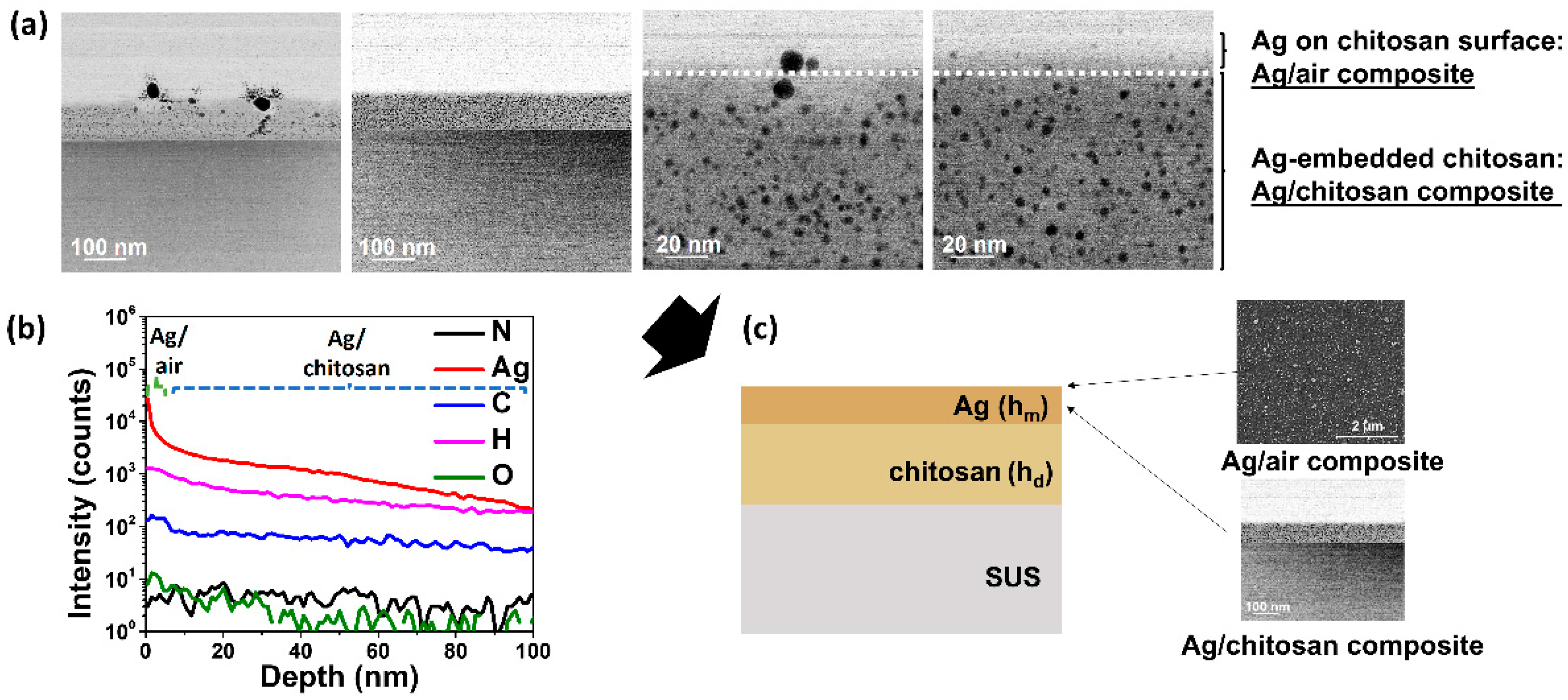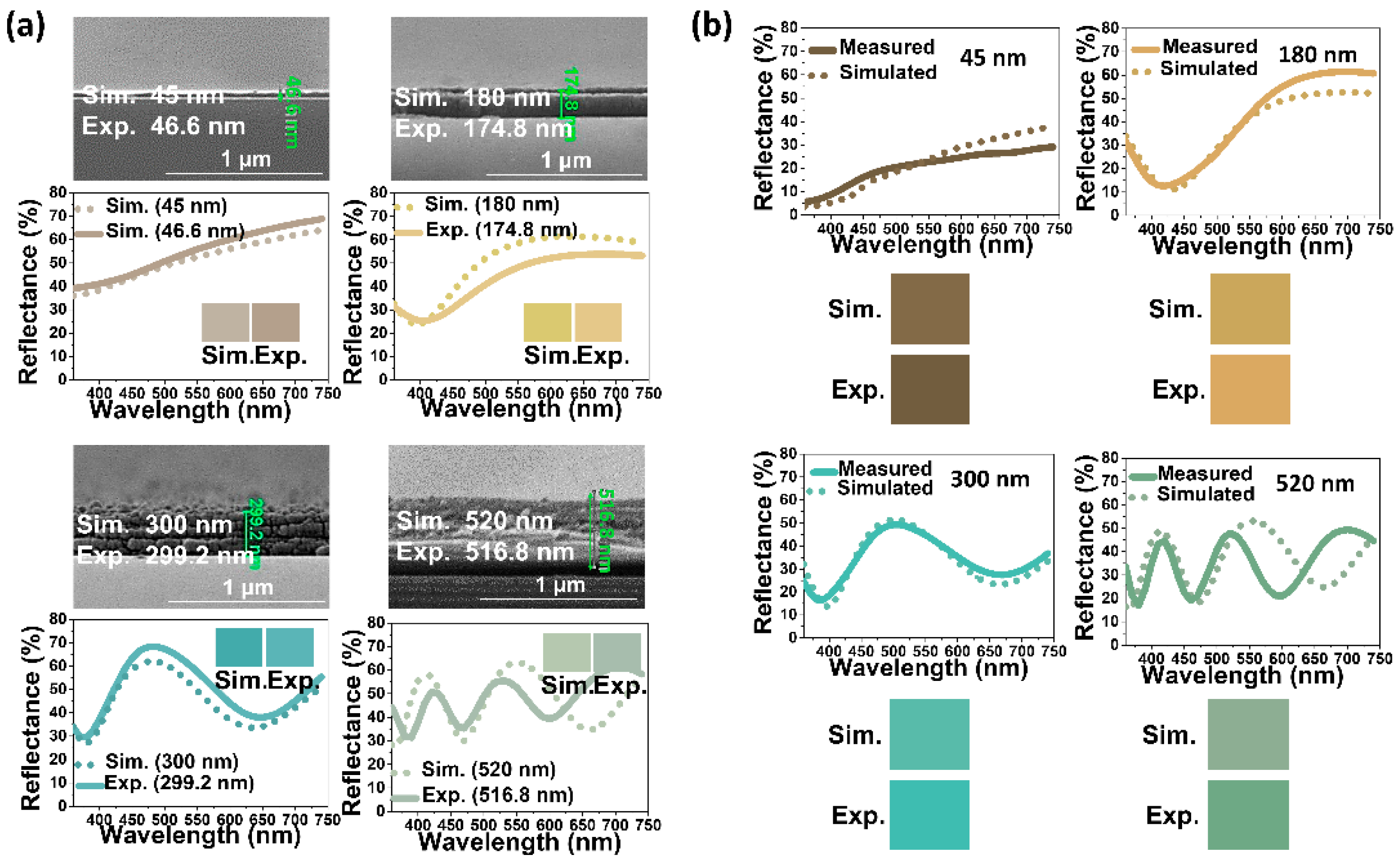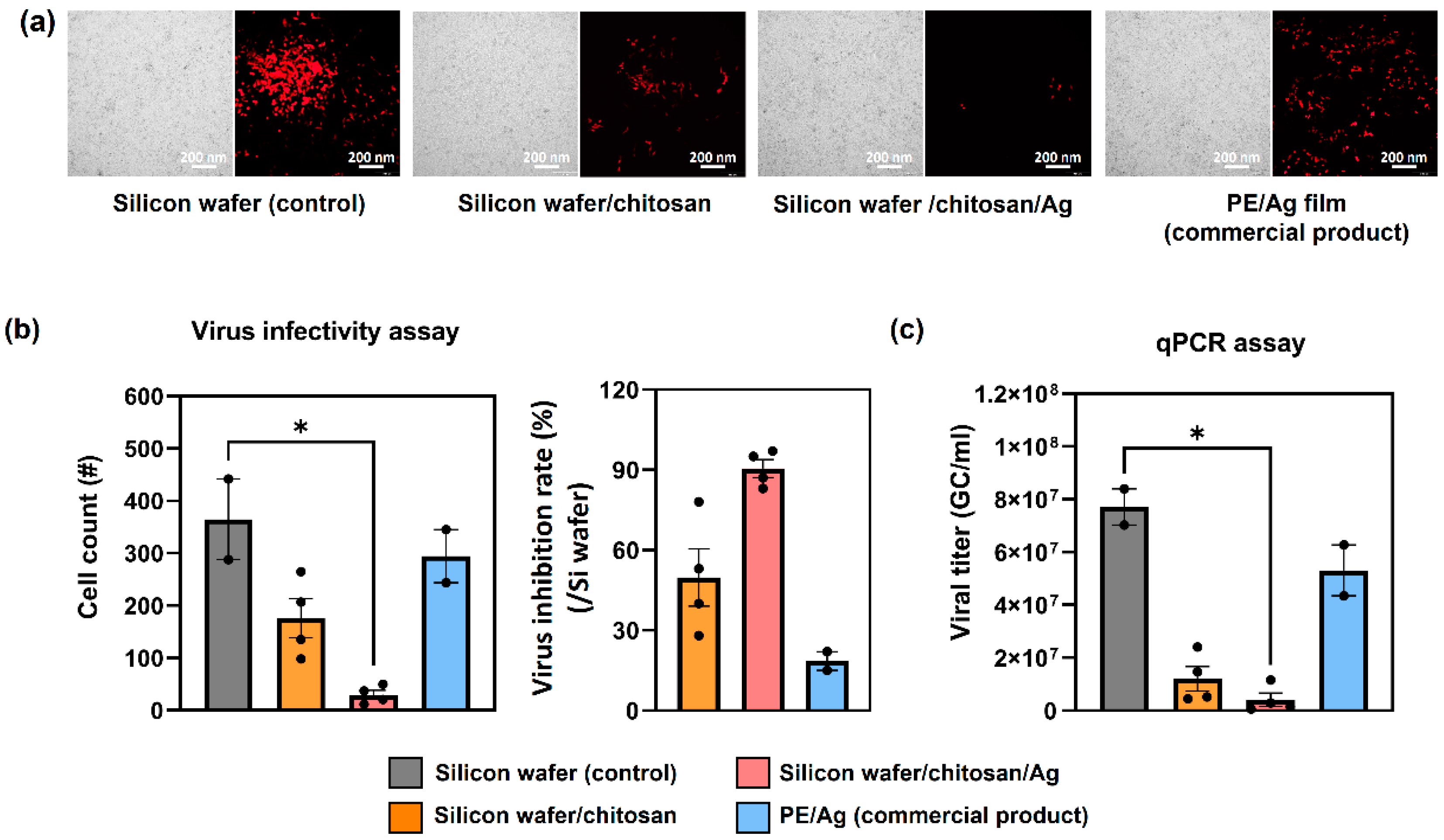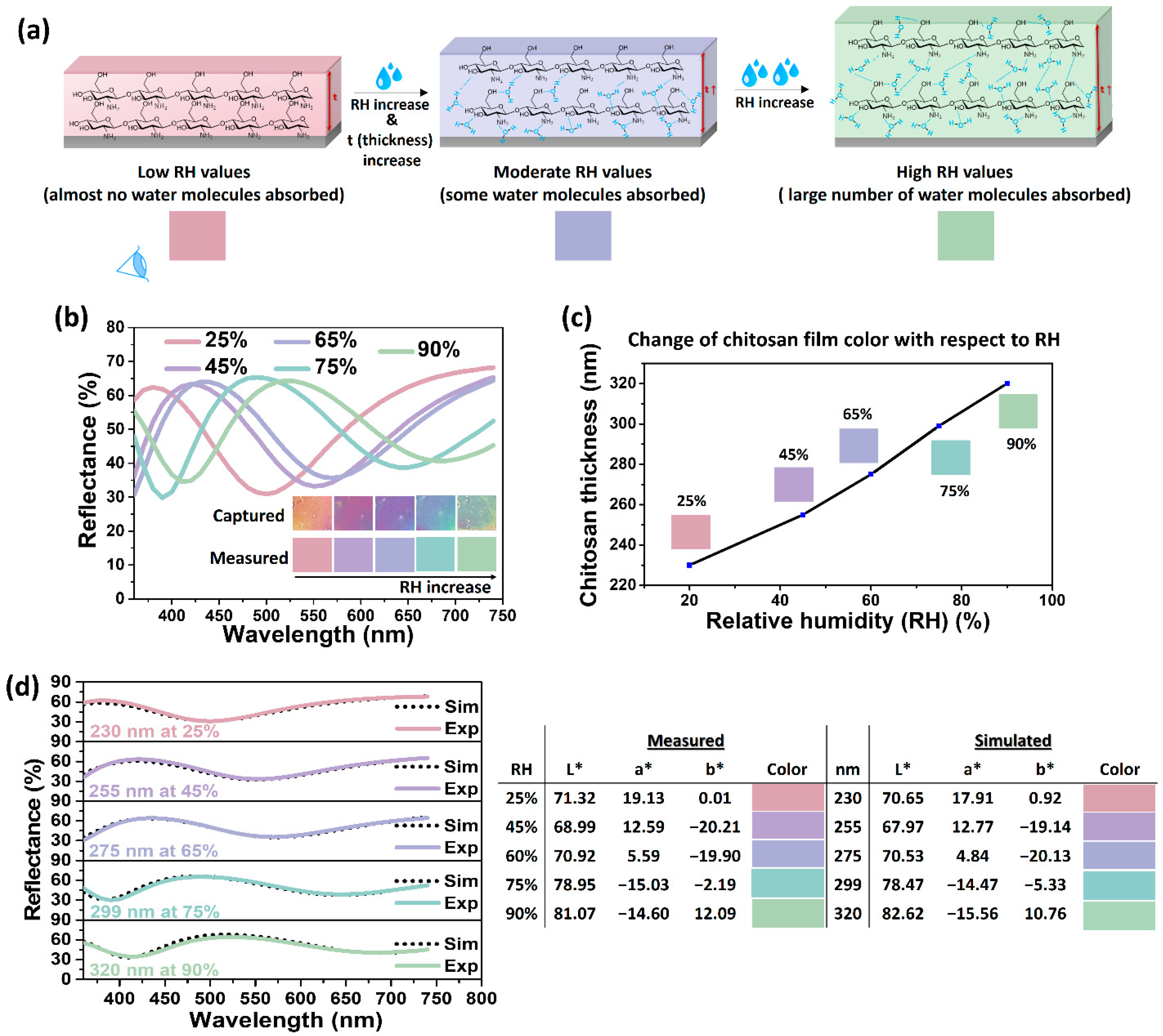Chitosan-Based Structural Color Films for Humidity Sensing with Antiviral Effect
Abstract
1. Introduction
2. Materials and Methods
2.1. Materials
2.2. Preparation of Chitosan Precursor Solution
2.3. Fabrication of Chitosan and Ag/Chitosan Films
2.4. Antiviral Tests
2.5. Humidity-Induced Color Change Experiments
2.6. Characterization
3. Results and Discussion
3.1. Characterization of Chitosan- and Ag/Chitosan-Derived Films
3.2. Chitosan- and Ag/Chitosan-Derived Structural Color Films
3.3. Antiviral and Antibacterial Activity of Chitosan and Ag/Chitosan Films
3.4. Humidity-Responsive Color Change in Chitosan Films
4. Conclusions
Supplementary Materials
Author Contributions
Funding
Data Availability Statement
Conflicts of Interest
References
- Kennedy, E.; Fecheyr-Lippens, D.; Hsiung, B.-K.; Niewiarowski, P.H.; Kolodziej, M. Biomimicry: A Path to Sustainable Innovation, Des. Issues 2015, 31, 66–73. [Google Scholar] [CrossRef]
- Ilieva, L.; Ursano, I.; Traista, L.; Hoffmann, B.; Dahy, H. Biomimicry as a Sustainable Design Methodology—Introducing the ‘Biomimicry for Sustainability’ Framework. Biomimetics 2022, 7, 37. [Google Scholar] [CrossRef] [PubMed]
- Nhandu, M.I.; Alibaba, H.Z. Biomimicry as an Alternative Approach to Sustainability. Archit. Res. 2018, 8, 1–11. [Google Scholar]
- Hayes, S.; Desha, C.; Baumeister, D. Learning from Nature—Biomimicry Innovation to Support Infrastructure Sustainability and Resilience. Technol. Forecast. Soc. Change 2020, 161, 120287. [Google Scholar] [CrossRef]
- Gamage, A.; Hyde, R. A Model Based on Biomimicry to Enhance Ecologically Sustainable Design. Archit. Sci. Rev. 2012, 55, 224–235. [Google Scholar] [CrossRef]
- Zhao, Y.; Xie, Z.; Gu, H.; Gu, Z. Bio-inspired Variable Structural Color Materials. Chem. Soc. Rev. 2012, 41, 3297–3317. [Google Scholar] [CrossRef]
- Xiong, R.; Grant, A.M.; Ma, R.; Zhang, S.; Tsukruk, V.V. Naturally-derived Biopolymer Nanocomposites: Interfacial Design, Properties and Emerging Applications. Mater. Sci. Eng. R Rep. 2018, 125, 1–41. [Google Scholar] [CrossRef]
- Ng, J.Y.; Obuobi, S.; Chua, M.L.; Zhang, C.; Hong, S.; Kumar, Y.; Gokhale, R.; Ee, P.L.R. Biomimicry of Microbial Polysaccharide Hydrogels for Tissue Engineering and Regenerative Medicine—A Review. Carbohydr. Polym. 2020, 241, 116345. [Google Scholar] [CrossRef]
- Arzt, E.; Quan, H.; McMeeking, R.M.; Hensel, R. Functional Surface Microstructures Inspired by Nature—From Adhesion and Wetting Principles to Sustainable New Devices. Prog. Mater. Sci. 2021, 120, 100823. [Google Scholar] [CrossRef]
- Xu, Q.; Zhang, W.; Dong, C.; Sreeprasad, T.S.; Xia, Z. Biomimetic Self-Cleaning Surfaces: Synthesis, Mechanism and Applications. J. R. Soc. Interface 2016, 12, 20160300. [Google Scholar] [CrossRef]
- Manoharan, K.; Bhattacharya, S. Superhydrophobic Surfaces Review: Functional Application, Fabrication Techniques and Limitations. J. Micromanuf. 2019, 2, 59–78. [Google Scholar] [CrossRef]
- Sfameni, S.; Rando, G.; Galetta, M.; Ielo, I.; Brucale, M.; De Leo, F.; Cardiano, P.; Cappello, S.; Visco, A.; Trovato, V.; et al. Design and Development of Fluorinated and Biocide-Free Sol-Gel Based Hybrid Functional Coatings for Anti-Biofouling/Foul-Release Activity. Gels 2022, 8, 538. [Google Scholar] [CrossRef]
- Zhai, W.; Bai, L.; Zhou, R.; Fan, X.; Kang, G.; Liu, Y.; Zhou, K. Recent Progress on Wear-Resistant Materials: Designs, Properties, and Applications. Adv. Sci. 2021, 8, 2003739. [Google Scholar] [CrossRef] [PubMed]
- Tang, Y.; Xu, J.-Y.; Chen, L.-Q.; Yang, T. Nonlinear Dynamics of an Enhanced Piezoelectric Energy Harvester Composed of Bi-directional Functional Graded Materials. Int. J. Non Linear Mech. 2023, 150, 104350. [Google Scholar] [CrossRef]
- Malshe, A.; Rajurkar, K.; Samant, A.; Hansen, H.; Bapat, S.; Jiang, W. Bio-inspired Functional Surfaces for Advanced Applications. CIRP Ann. Manuf. Technol. 2013, 62, 607–628. [Google Scholar] [CrossRef]
- Liu, J.; Qu, S.; Suo, Z.; Yang, W. Functional Hydrogel Coatings. Natl. Sci. Rev. 2021, 8, 254. [Google Scholar] [CrossRef] [PubMed]
- Balasubramaniam, B.; Prateek; Ranjian, S.; Saraf, M.; Kar, P.; Singh, S.P.; Thakur, V.K.; Singh, A.; Gupta, R.K. Antibacterial and Antiviral Functional Materials: Chemistry and Biological Activity toward Tackling COVID-19-like Pandemics. ACS Pharmacol. Transl. Sci. 2021, 4, 8–54. [Google Scholar] [CrossRef] [PubMed]
- Murphy, M.; Aksak, B.; Sitti, M. Gecko-inspired Directional and Controllable Adhesion. Nanomicro Small 2009, 2, 170–175. [Google Scholar] [CrossRef]
- Parker, A.R. 515 Million Years of Structural Color. J. Opt. A Pure Appl. Opt. 2000, 2, 15–28. [Google Scholar] [CrossRef]
- Ingram, A.; Parker, A. A Review of the Diversity and Evolution of Photonic Structures in Butterflies, Incorporating the Work of John Huxley (The Natural History Museum, London from 1961 to 1990). Philos. Trans. R. Soc. Lond. B Biol. Sci. 2008, 363, 2465–2480. [Google Scholar] [CrossRef]
- Kinoshita, S.; Yoskioka, S. Structural Colors in Nature: The Role of Regularity and Irregularity in the Structure. ChemPhysChem 2005, 6, 1442–1459. [Google Scholar] [CrossRef]
- Kim, Y.; Quan, Y.; Cho, Y.; Ahn, S. Lithography-free and Highly Angle Sensitive Structural Coloration Using Fabry-Perot Resonance of Tin. Int. J. Precis. Eng. Manuf. Green Technol. 2021, 8, 997–1006. [Google Scholar] [CrossRef]
- Han, J.T.; Kim, B.K.; Woo, S.J.; Jang, J.I.; Cho, J.Y.; Jeong, H.J.; Jeong, S.Y.; Jeong, S.Y.; Seo, S.H.; Lee, G.W. Bioinspired Multifunctional Superhydrophobic Surfaces with Carbon-Nanotube-based Conducting Pastes by Facile and Scalable Printing. ACS Appl. Mater. Interfaces 2017, 9, 7780–7786. [Google Scholar] [CrossRef] [PubMed]
- Su, X.; Li, H.; Lai, X.; Chen, Z.; Zeng, X. Highly Stretchable and Conductive Superhydrophobic Coating for Flexible Electronics. ACS Appl. Mater. Interfaces 2018, 10, 10587–10597. [Google Scholar] [CrossRef] [PubMed]
- Umar, M.; Min, K.; Jo, M.; Kim, S. Ultra-thin, Conformal, and Hydratable Color-absorbers Using Silk Protein Hydrogel. Opt. Mater. 2018, 80, 241–246. [Google Scholar] [CrossRef]
- Shimazaki, T.; Kawakubo, Y.; Hara, S.; Hitosugi, T.; Yokoyama, T.; Miki, Y. Blood Leakage Determination Using the Chromaticity of a Color Sensor. Adv. Biomed. Eng. 2019, 8, 177–184. [Google Scholar] [CrossRef]
- Li, Q.; Qi, N.; Peng, Y.; Zhang, Y.; Shi, L.; Zhang, X.; Lai, Y.; Wei, K.; Kim, I.S.; Zhang, K.-Q. Sub-micron Silk Fibroin Film with High Humidity Sensibility through Color Changing. RSC Adv. 2017, 7, 17889–17897. [Google Scholar] [CrossRef]
- Zhang, Y.P.; Chodavarapu, V.P.; Kirk, A.G.; Andrews, M.P. Structured Color Humidity Indicator from Reversible Pitch Tuning in Self-assembled Nanocrystalline Cellulose Films. Sens. Actuators B 2013, 176, 692–697. [Google Scholar] [CrossRef]
- Azofeifa, D.E.; Arguedas, H.J.; Vargas, W.E. Optical Properties of Chitin and Chitosan Biopolymers with Application to Structural Color Analysis. Opt. Mater. 2012, 35, 175–183. [Google Scholar] [CrossRef]
- Narkevicius, A.; Parker, R.M.; Ferrer-Orri, J.; Parton, T.G.; Lu, Z.; van de Kerkhof, G.T.; Frka-Petesic, B.; Vignolini, S. Revealing the Structural Coloration of Self-Assembled Chitin Nanocrystal Films. Adv. Mater. 2022, 34, 2203300. [Google Scholar] [CrossRef]
- Wang, W.; Meng, Q.; Li, Q.; Liu, J.; Jin, Z.; Zhao, K. Chitosan Derivatives and Their Application in Biomedicine. Int. J. Mol. Sci. 2020, 21, 487. [Google Scholar] [CrossRef] [PubMed]
- Duan, C.; Meng, X.; Meng, J.; Khan, M.I.H.; Dai, L.; Khan, A.; An, X.; Zhang, J.; Huq, T.; Ni, Y. Chitosan as A Preservative for Fruits and Vegetables: A Review on Chemistry and Antimicrobial Properties. J. Bioresour. Bioprod. 2019, 4, 11–21. [Google Scholar] [CrossRef]
- Kumar, A.; Yadav, S.; Pramanik, J.; Sivamaruthi, B.S.; Jayeoye, T.J.; Prajapati, B.G.; Chaiyasut, C. Chitosan-Based Composites: Development and Perspective in Food Preservation and Biomedical Applications. Polymers 2023, 15, 3150. [Google Scholar] [CrossRef] [PubMed]
- Sun, Z.; Yue, Y.; He, W.; Jiang, F.; Lin, C.-H.; Pui, D.Y.H.; Liang, Y.; Wang, J. The Antibacterial Performance of Positively Charged and Chitosan Dipped Air Filter Media. Build. Environ. 2020, 180, 107020. [Google Scholar] [CrossRef]
- Liu, B.-H.; Xie, G.-Z.; Li, C.Z.; Wang, S.; Yuan, Z.; Duan, Z.-H.; Jiang, Y.-D.; Tai, H.-L. A Chitosan/Amido-Graphene Oxide-Based Self-Powered Humidity Sensor Enabled by Triboelectric Effect. Rare Met. 2021, 40, 1995–2003. [Google Scholar] [CrossRef]
- Chen, L.H.; Chan, C.C.; Menon, R.; Balamurali, P.; Shaillender, M.; Neu, B.; Ang, X.M.; Zu, P.; Wong, W.C.; Leong, K.C. Chitosan Based Fiber-Optic Fabry-Perot Humidity Sensor. Sens. Actuators B Chem. 2012, 169, 167–172. [Google Scholar] [CrossRef]
- Amankwaah, C.; Li, J.; Lee, J.; Pascall, M.A. Development of Antiviral and Bacteriostatic Chitosan-Based Food Packaging Material with Grape Seed Extract for Murine Norovirus, Escherichia coli and Listeria innocua Control. Food Sci. Nutr. 2020, 8, 6174–6181. [Google Scholar] [CrossRef]
- Khubiev, O.M.; Egorov, A.R.; Kirichuk, A.A.; Khrustalev, V.N.; Tskhovrebov, A.G.; Kritchenkov, A.S. Chitosan-Based Antibacterial Films for Biomedical and Food Applications. Int. J. Mol. Sci. 2023, 24, 10738. [Google Scholar] [CrossRef]
- Kardas, I.; Struszczyk, M.H.; Kucharska, M.; van den Broek, L.A.M.; van Dam, J.E.G.; Ciechańska, D. Chitin and Chitosan as Functional Biopolymers for Industrial Applications. In The European Polysaccharide Network of Excellence (EPNOE); Navard, P., Ed.; Springer: Vienna, Austria, 2012. [Google Scholar] [CrossRef]
- Shao, W.-C.; Wu, H.; Shiue, A.; Tseng, C.-H.; Wang, Y.-W.; Hsu, C.-F.; Leggett, G. Chitosan-dosed Adsorptive Filter Media for Removal of Formaldehyde from Indoor Air—Performance and Cancer Risk Assessment. Chem. Phys. Lett. 2021, 779, 138836. [Google Scholar] [CrossRef]
- Florez, M.; Guerra-Rodriguez, E.; Cazon, P.; Vazquez, M. Chitosan for Food Packaging: Recent Advanced in Active and Intelligent Films. Food Hydrocoll. 2022, 124, 107328. [Google Scholar] [CrossRef]
- Aider, M. Chitosan Application for Active Bio-Based Films Production and Potential in the Food Industry: Review. LWT Food Sci. Technol. 2010, 43, 837–842. [Google Scholar] [CrossRef]
- Stefanowska, K.; Wosniak, M.; Dobrucka, R.; Ratajczak, I. Chitosan with Natural Additives as a Potential Food Packaging. Materials 2023, 16, 1579. [Google Scholar] [CrossRef] [PubMed]
- Zhang, Y.; Zhang, H.; Chen, S.; Fu, H.; Zhao, Y. Microwave-assisted Degradation of Chitosan with Hydrogen Peroxide Treatment Using Box-Behnken Design for Enhanced Antibacterial Activity. Int. J. Food Sci. 2018, 53, 156–165. [Google Scholar] [CrossRef]
- Choi, C.; Nam, J.-P.; Nah, J.-W. Application of Chitosan and Chitosan Derivatives as Biomaterials. J. Ind. Eng. Chem. 2016, 33, 1–10. [Google Scholar] [CrossRef]
- Jang, J.; Kang, K.; Raeis-Hosseini, N.; Ismukhanova, A.; Jeong, H.; Jung, C.; Kim, B.; Lee, J.-Y.; Park, I.; Rho, J. Self-Powered Humidity Sensor Using Chitosan-based Plasmonic Metal-Hydrogen-Metal Filters. Adv. Opt. Mater. 2020, 8, 1901932. [Google Scholar] [CrossRef]
- Li, Z.; Butun, K.; Aydin, K. Large-area, Lithography-free Super Absorbers and Color Filters at Visible Frequencies Using Ultrathin Metallic Films. ACS Photonics 2015, 2, 183–188. [Google Scholar] [CrossRef]
- Wu, S.; Liu, T.; Tang, B.; Li, L.; Zhang, S. Interfaces, Structural Color Circulation in a Bilayer Photonic Crystal by Increasing the Incident Angle. ACS Appl. Mater. Interfaces 2019, 11, 10171–10177. [Google Scholar] [CrossRef]
- Guibal, E. Interactions of Metal Ions with Chitosan-based Sorbents: A Review. Sep. Purif. Technol. 2004, 1, 43–74. [Google Scholar] [CrossRef]
- Allawadhi, P.; Singh, A.; Khurana, A.; Khurana, I.; Allwadhi, S.; Kumar, P.; Banothu, A.K.; Thalugula, S.; Barani, P.J.; Naik, R.R.; et al. Silver Nanoparticle Based Multifunctional Approach for Combating COVID-19. Sens. Int. 2021, 2, 100101. [Google Scholar] [CrossRef]
- Minoshima, M.; Lu, Y.; Kimura, T.; Nakano, R.; Ishiguro, H.; Kubota, Y.; Hashimoto, K.; Sunada, K. Comparison of the Antiviral Effect of Solid-state Copper and Silver Compounds. J. Hazard. Mater. 2016, 312, 1–7. [Google Scholar] [CrossRef]
- Burak, D.; Rahman, M.A.; Seo, D.-C.; Byun, J.Y.; Han, J.; Lee, S.E.; Cho, S.-H. In Situ Metal Deposition on Perhydropolysilazane-Derived Silica for Structural Color Surfaces with Antiviral Activity. ACS Appl. Mater. Interfaces 2023, 15, 54143–54156. [Google Scholar] [CrossRef] [PubMed]
- Kim, Y.H.; Rahman, M.A.; Hwang, J.S.; Ko, H.; Huh, J.Y.; Byun, J.Y. Reflection Color Tuning of a Metal-insulator-metal Cavity Structure Using Arc Plasma Deposition of Gold Nanoparticles. Appl. Surf. Sci. 2021, 562, 150140. [Google Scholar] [CrossRef]
- Bard, A.J.; Parsons, B.; Jordon, J. (Eds.) Standard Potentials in Aqueous Solutions; Dekker: New York, NY, USA, 1985. [Google Scholar]
- Ahmadi, F.; Oveisi, Z.; Samani, S.M.; Amoozgar, Z. Chitosan Based Hydrogels: Characteristics and Pharmaceutical Applications. Res. Pharm. Sci. 2015, 10, 1–16. [Google Scholar] [PubMed]
- Grzabka-Zasadzinska, A.; Amierszajew, T.; Borysiak, S. Thermal and Mechanical Properties of Chitosan Nanocomposites with Cellulose Modified in Ionic Liquids. J. Therm. Anal. Calorim. 2017, 130, 143–154. [Google Scholar] [CrossRef]
- Mondal, M.I.H.; Saha, J. Antimicrobial, UV Resistant and Thermal Comfort Properties of Chitosan- and Aloe vera-Modified Cotton Woven Fabric. J. Polym. Environ. 2019, 27, 405–420. [Google Scholar] [CrossRef]
- Rahman, M.A.; Vivek, S.M.K.; Kim, S.H.; Byun, J.Y. Polarizonic-interference Coloration of Stainless Steel Surfaces by Au-Al2O3 Nanocomposite Thin Film Coating. Appl. Surf. Sci. 2020, 505, 144428. [Google Scholar] [CrossRef]
- Thanh, N.T.K.; Maclean, N.; Mahiddine, S. Mechanisms of Nucleation and Growth of Nanoparticles in Solution. Chem. Rev. 2014, 114, 7610–7630. [Google Scholar] [CrossRef] [PubMed]
- Tang, H.; Zhu, C.; Meng, G.; Wu, N. Review—Surface Enhanced Raman Scattering Sensors for Food Safety and Environmental Monitoring. J. Electrochem. Soc. 2018, 165, 3098–3118. [Google Scholar] [CrossRef]
- Chirkov, S.N. The Antiviral Activity of Chitosan (Review). Appl. Biochem. Microbiol. 2002, 38, 1–8. [Google Scholar] [CrossRef]
- Sharma, N.; Modak, C.; Singh, P.K.; Kumar, R.; Khatri, D.; Singh, S.B. Underscoring the Immense Potential of Chitosan in Fighting a Wide Spectrum of Viruses: A Plausible Molecule Against SARS-CoV-2? Int. J. Biol. Macromol. 2021, 179, 33–44. [Google Scholar] [CrossRef]
- Jaber, N.; Al-Remawi, M.; Al-Akayleh, F.; Al-Muhtaseb, N.; Al-Adham, I.S.I.; Collier, P.J. A Review of the Antiviral Activity of Chitosan, Including Patented Applications and Its Potential Use Against COVID-19. J. Appl. Microbiol. 2022, 1, 41–58. [Google Scholar] [CrossRef] [PubMed]
- Medhi, R.; Srinoi, P.; Ngo, N.; Tran, H.-V.; Lee, T.R. Nanoparticle-based Strategies to Combat COVID-19. ACS Appl. Nano Mater. 2020, 3, 8557–8580. [Google Scholar] [CrossRef] [PubMed]
- Loutfy, S.A.; Abdel-Salam, A.I.; Moatasim, Y.; Goma, M.R.; Abdel Fattah, N.F.; Emam, M.H.; Ali, F.; ElShehaby, H.A.; Ragab, E.A.; Alam El-Din, H.M.; et al. Ativiral Activity of Chitosan Nanoparticles Encapsulating Silymarin (Sil-CNPs) Against SARS-CoV-2 (in silico and in vitro study). RSC Adv. 2022, 12, 15775. [Google Scholar] [CrossRef]
- Balagna, C.; Francese, R.; Perero, S.; Lembo, D.; Ferraris, M. Nanostructured Composite Coating Endowed with Antiviral Activity Against Human Respiratory Viruses Deposited on Fibre-based Air Filters. Surf. Coat. Technol. 2021, 409, 126873. [Google Scholar] [CrossRef]
- Yin, M.; Hu, J.; Huang, M.; Chen, P.; Zhang, Y. Moisture-induced Reversible Material Transition Behavior of Nickel (II) Bromide for Low Humidity Detection. Sens. Actuators B Chem. 2021, 331, 112911. [Google Scholar] [CrossRef]
- Duan, Z.; Li, J.; Yuan, Z.; Jiang, Y.; Tai, H. Capacitive Humidity Sensor Based on Zirconium Phosphate Nanoplates Film with Wide Sensing Range and High Response. Sens. Actuators B Chem. 2023, 394, 134445. [Google Scholar] [CrossRef]
- Georgaki, M.-I.; Oikonomou, P.; Botsialas, A.; Papanikolaou, N.; Raptis, I.; Argitis, P.; Chatzichristidi, M. Powerless and Reversible Color Humidity Sensor. Procedia Eng. 2011, 25, 1177–1180. [Google Scholar] [CrossRef]
- Mergu, N.; Kim, H.; Ryu, J.; Son, Y.-A. A Simple and Fast Responsive Colorimetric Moisture Sensor Based on Symmetrical Conjugated Polymer. Sens. Actuators B Chem. 2020, 311, 127906. [Google Scholar] [CrossRef]
- Kim, E.; Kim, S.Y.; Jo, G.; Kim, S.; Park, M.J. Colorimetric and Resistive Polymer Electrolyte Thun Films for Real-Time Humidity Sensors. ACS Appl. Mater. Interfaces 2012, 4, 5179–5187. [Google Scholar] [CrossRef]
- D’Amato, R.; Polimadei, A.; Terranova, G.; Caponero, M.A. Humidity Sensing by Chitosan-Coated Fibre Bragg Gratings (FBG). Sensors 2021, 21, 3348. [Google Scholar] [CrossRef]
- Aguirre-Loredo, R.Y.; Rodriguez-Hernandez, A.I.; Morales-Sanchez, E.; Gomez-Aldapa, C.A.; Velazquez, G. Effect of Equilibrium Moisture Content on Barrier, Mechanical and Thermal Properties of Chitosan Films. Food Chem. 2016, 196, 560–566. [Google Scholar] [CrossRef] [PubMed]
- Kumari, P.; Kumar, A.; Yadav, A.; Gupta, G.; Gupta, G.; Shivagan, D.D.; Bapna, K. Chitosan-Based Highly Sensitive Viable Humidity Sensor for Human Health Monitoring. ACS Omega 2023, 8, 39511–39522. [Google Scholar] [CrossRef] [PubMed]
- Qi, P.; Xu, Z.; Zhou, T.; Zhang, T.; Zhao, H. Study on a Quartz Crystal Microbalance Sensor Based on Chitosan-Functionalized Mesoporous Silica for Humidity Detection. J. Colloid Interface Sci. 2021, 583, 340–350. [Google Scholar] [CrossRef] [PubMed]






Disclaimer/Publisher’s Note: The statements, opinions and data contained in all publications are solely those of the individual author(s) and contributor(s) and not of MDPI and/or the editor(s). MDPI and/or the editor(s) disclaim responsibility for any injury to people or property resulting from any ideas, methods, instructions or products referred to in the content. |
© 2024 by the authors. Licensee MDPI, Basel, Switzerland. This article is an open access article distributed under the terms and conditions of the Creative Commons Attribution (CC BY) license (https://creativecommons.org/licenses/by/4.0/).
Share and Cite
Burak, D.; Seo, D.-C.; An, H.-E.; Jeong, S.; Lee, S.E.; Cho, S.-H. Chitosan-Based Structural Color Films for Humidity Sensing with Antiviral Effect. Nanomaterials 2024, 14, 351. https://doi.org/10.3390/nano14040351
Burak D, Seo D-C, An H-E, Jeong S, Lee SE, Cho S-H. Chitosan-Based Structural Color Films for Humidity Sensing with Antiviral Effect. Nanomaterials. 2024; 14(4):351. https://doi.org/10.3390/nano14040351
Chicago/Turabian StyleBurak, Darya, Dong-Chan Seo, Hong-Eun An, Sohee Jeong, Seung Eun Lee, and So-Hye Cho. 2024. "Chitosan-Based Structural Color Films for Humidity Sensing with Antiviral Effect" Nanomaterials 14, no. 4: 351. https://doi.org/10.3390/nano14040351
APA StyleBurak, D., Seo, D.-C., An, H.-E., Jeong, S., Lee, S. E., & Cho, S.-H. (2024). Chitosan-Based Structural Color Films for Humidity Sensing with Antiviral Effect. Nanomaterials, 14(4), 351. https://doi.org/10.3390/nano14040351







